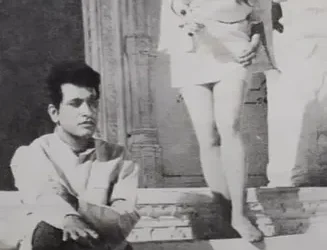It was at Good Earth that Dhir showcased his first collection. The Delhi-based retail space that houses some of the most exquisite apparel and décor was founded by Anita Lal more than two decades ago.
You can spot his designs from afar, not because they scream for attention, but because they have a distinct personality, just like the designer himself. Winner of the International Woolmark Prize for menswear 2016, Dhir has created a brand backed by an incredible story. “My brand is a reflection of myself. It comes from where I come from, the roots of India. Ive grown up listening to tales of different crafts and cultures from my grandmother, and theyre a big part of who I am,” adds Dhir. We spoke to the designer about his minimal aesthetic, sustainability, and future plans. Read on.
Design and inspiration
Dhir is known for revamping Indian textiles. His clothes speak volumes about his refined aesthetic. He launched his label in 2011 and, for the first eight years, only did menswear. “Initially, it was a lot of cotton, linen, and silk, followed by ikat, brocade, and other materials. I like to design and make things that I can wear. If I can’t wear it, I won’t make it.” What inspires him? He says, “My own life, and everything around me. I have a set of close friends who are non-fashion. There’s so much to gather from their lives and experiences. “I’m a curious person who enjoys observing and learning from the people around me and the places I visit.”
First outing
It was at Good Earth that Dhir showcased his first collection. The Delhi-based retail space that houses some of the most exquisite apparel and décor was founded by Anita Lal more than two decades ago. “She is my mentor, and she encouraged me to do more and better. She was the first person who I showed my collection to, and it was love at first sight. When we met for the first time, we felt like we came from the same place. Our aesthetic might be slightly different, but there’s so much synergy-there’s a very natural sync.” He continues to add, “She is someone who you can learn a lot from. She is humble and honest, and she’s been there throughout my career. “
Sustainable fashion
“I’d like to think of myself as the ‘OG’ sustainable brand, but I insisted on removing the term from all my communications a few years back. It was getting too dogmatic.” For Dhir, sustainability has an alternate meaning. He believes in “buy less, buy good,” a life lesson his grandmother passed onto him. In the past few years, the Indian fashion industry has been slowly inching towards sustainability and conscious consumerism. Planet positivity, recycling, and upcycling are terms that are gaining relevance. “For me, buying ‘good’ means something that is fashionable, classic, relevant, high-quality, low-maintenance, versatile, and is a collectible. Sustainable fashion is far more holistic for me than just buying organic. It has to be a responsible fashion move. For example, all our fabrics are biodegradable and high-quality and can be passed down through generations, making them reusable,” says the designer.
Current fashion scene
Dhir’s design philosophy is dominated by textiles that are converted into luxurious, unique pieces. Whether it’s his minutely detailed menswear, his brocade pantsuits for women, or his whimsical prints, he’s here to inject our everyday fashion with all things unique. On being asked about the one thing he would like to change in the current Indian fashion scene, he says, “I would undo the ‘Bollywoodisation’ of Indian weddings. They have become so homogenous that everything looks the same. The cultural shift is missing. It’s just the same lehenga choli everywhere. The beauty of our country lies in its different cultures, and it would be nice to see some diversity. “
Business and more
The toughest time for me was after winning the Woolmark. Too much happened too soon. I was ready as a designer, but not as a company. However, today I’m more settled and ready to expand and diversify,” says Dhir. He adds, “I want to jump into décor, crockery, swimwear; the list is endless. But I only want to collaborate with experts as that’s the best way to do it.”
His brand is not only popular in big cities but in smaller towns as well. He recently showcased his collection at Amiraah, a multi-designer store in Kanpur, and feels that there’s no difference between the two. I think it’s the same consumer now. “Social media has bridged all kinds of gaps that existed, making everyone stay connected and updated,” says Dhir.























